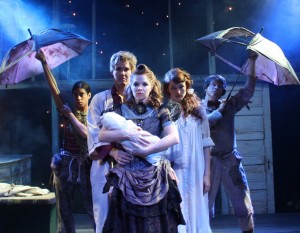Play creates darker version of J.M. Barrie’s classic tale
Before Disney’s Peter, Wendy, John and Michael flew over “poor Nana” toward Big Ben and continued to the second star to the right and straight on ’till morning, J.M. Barrie told the story of a young girl grappling with having to grow up much earlier than most. The Blank Theater in Hollywood is currently showing Peter Pan: The Boy Who Hated Mothers, adapted by Michael Lluberes and directed by Michael Matthews, a play that stays much more true to Barrie’s original telling of Peter and Wendy.

Re-imagination · Michael Llubete’s adaptation brings out a new side of Peter Pan by giving it a more realistic, even lustful makeover. – Courtesy of Mary Ann Williams
Darker themes rest under the surface of this play, unlike in the simplistic Disney rendition, giving a quality of reality to a play filled with imagination, flying boys, ticking crocodiles and bloodthirsty pirates. As is made obvious by the title, mothers are a pivotal theme; however, saying Peter hates mothers is ironic, for his feelings are much more complex and tormented.
To Wendy’s astonishment, Peter definitively says he has no mother. We later learn that Peter’s mother actually forgets about him after he goes to Neverland. He returns home to find his window locked and another boy in his bed. Speaking of the lost boys, Peter says they are children whose mothers do not want them or miss them upon their departures. When Wendy lands in Neverland, she immediately becomes the “mother” of the lost boys and Peter.
Liza Burns embodies the complex role of Wendy with finesse and ease. While remaining child-like in her intonation, movements and wardrobe (a cotton nightdress and her hair in a ponytail and bow), Burns lets Wendy’s intelligence show through in her explaining to Peter facts about life, her motherly instincts when stitching Peter’s shadow back on and her empathy for her own mother. Skillfully, Burns, with the help of Lluberes and Matthews, embodies this dichotomy of child and adult — while always remaining true to the fact that her character is simply a young girl.
Captain Hook, one of literature’s most infamous villains, is perhaps the most fascinating and complex of the characters in this play because of Trisha LaFache, the portrayer of Hook. While the actor is female, her gender neither takes away from Hook’s depraved manner nor from the character’s lust for the death of Peter Pan. Watching LaFache perform makes it almost impossible to believe that Hook’s words were once merely a script, for she brings vitality and insanity to the character through her tonal fluctuations, hand gestures and facial expressions. Hook’s transitions from crazed rants to immediate silence and long pauses followed by slower, more methodical speech, illustrates the torment and turmoil within Hook’s psychosis. Knowing that his end is always around the corner (thanks to the ticking clock inside the crocodile), Hook manifests a fear of death that is present in us all and one that ties directly back to the theme of infinite childhood and the ultimate implications of growing up.
Though the theater cannot accommodate more than about 30 audience members, the actors’ talents and presence can captivate an audience five times this size. With a stage no bigger than a bedroom, the cast size is limited to about 10. The production company efficiently and ingeniously solves this dilemma: Tinkerbell is merely a glowing ball on a string, and the three lost boys are also Captain Hook’s crew and sundry other. Though this proves confusing at first, the audience quickly catches on to the switch thanks to the actors’ abilities to transition while remaining true to the individual characters they are portraying.
Similar to LaFache, Amy Lawhorn never lets her gender become a source of distraction or confusion. Though she plays Nibs, a traditionally male role, she fully embodies the part.
By not casting according to the characters’ gender, the play in itself becomes more universal, more relatable to the audience. Assuming that only a man would want Peter Pan dead creates a confined and typified image of a villain; however, with a female in this role, the thought that Hook could be anyone, that evil resides in everyone, as does the fear of death, creates a profound impact.
Mary Hamrick, the set designer for Peter Pan, superbly incorporates props into the permanent set; hanging on the walls of the stage are numerous shelves and cupboards that housed various knickknacks, such as the orb of Tinkerbelle or string on which other props would hang. There is a gas lamp hanging on the wall that is used in the London nursery, hung back upon the wall, and then is taken down and used in Neverland. This setup allows transitions to be made seamlessly, costumes to be changed in moments, and yet never confuses audience members or draw their attention away from the action at hand. Small details such as these exemplify the talent and experience of the crew, which mimics that of the cast.
Eventually, Wendy, John and the lost boys return to London and the play takes audiences years ahead, showing them as content, average adults. Peter, on the other hand, is left in Neverland, with no Captain Hook for a nemesis, no lost boys and no Wendy; him forgetting Wendy proves heart-wrenching. Pity at first is sent to Wendy, but as she gets older and forges her own life, the pity finds its rightful home in Peter Pan, the boy who never grew up, the boy who never faced the world, the boy who remained alone for the rest of his days.
For while being a child is magical, it also is ephemeral. All children must grow up. The world awaits them.
